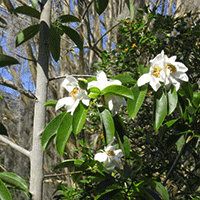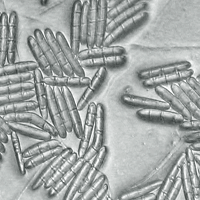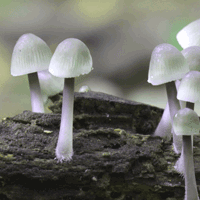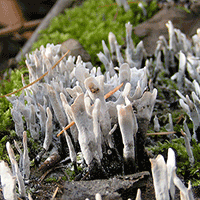
Inorganic and organic nitrogen uptake by nine dominant subtropical tree species
Changcheng Li (1-2), Qianru Li (1-2), Na Qiao (3), Xingliang Xu (1) , Qingkang Li (1), Huimin Wang (1)
iForest - Biogeosciences and Forestry, Volume 9, Issue 2, Pages 253-258 (2015)
doi: https://doi.org/10.3832/ifor1502-008
Published: Dec 02, 2015 - Copyright © 2015 SISEF
Research Articles
Abstract
We explored inorganic and organic N uptake patterns by dominant tree species in a subtropical plantation of southern China to improve understanding of nitrogen (N) cycling in these forests. We labeled intact roots by brief 15N exposures in field hydroponic experiments. Nine dominant tree species were examined to compare the effects of functional plant group (conifers versus broadleaves), mycorrhizal types, and forest successional stages on N uptake. All investigated species took up glycine at lower rates than other N forms, with mean values of 2.55 ± 0.36 µg N g-1 d.w. root h-1. Nitrate uptake rates for all species (average 5.81 ± 0.35 µg N g-1 d.w. root h-1) were significantly lower than ammonium (36.86 ± 5.17 µg N g-1 d.w. root h-1). All investigated species absorbed ammonium for more than 80% of total N uptake. Nitrate acquisition by these species was about 14% of total N uptake, with only 6% for glycine. Conifers showed significantly higher uptake rates of glycine, but lower uptake of nitrate than broadleaves. Arbuscular mycorrhizal (AM) and ectomycorrhizal (ECM) tree species showed significant difference in nitrate uptake, with higher rates by AM tree species. Tree species at late-successional forest stages showed higher uptake rates of nitrate than those in earlier successional stages. Our findings indicate that ammonium is the dominant N source and glycine is a minor N source throughout forest succession.
Keywords
Plant Functional Group, AM Fungi, ECM Fungi, N Uptake, Subtropical Tree Species, Succession
Authors’ Info
Authors’ address
Qianru Li
Xingliang Xu
Qingkang Li
Huimin Wang
Key Laboratory of Ecosystem Network Observation and Modeling, Institute of Geographic Sciences and Natural Resources Research, Chinese Academy of Sciences, Beijing 100101 (China)
Key Laboratory of Tropical Forest Ecology, Xishuangbanna Tropical Botanical Garden, Chinese Academy of Sciences, No. 88 Xuefu Road, Kunming 650223, Yunnan (P.R. China)
Corresponding author
Paper Info
Citation
Li C, Li Q, Qiao N, Xu X, Li Q, Wang H (2015). Inorganic and organic nitrogen uptake by nine dominant subtropical tree species. iForest 9: 253-258. - doi: 10.3832/ifor1502-008
Academic Editor
Giustino Tonon
Paper history
Received: Nov 14, 2014
Accepted: Oct 07, 2015
First online: Dec 02, 2015
Publication Date: Apr 26, 2016
Publication Time: 1.87 months
Copyright Information
© SISEF - The Italian Society of Silviculture and Forest Ecology 2015
Open Access
This article is distributed under the terms of the Creative Commons Attribution-Non Commercial 4.0 International (https://creativecommons.org/licenses/by-nc/4.0/), which permits unrestricted use, distribution, and reproduction in any medium, provided you give appropriate credit to the original author(s) and the source, provide a link to the Creative Commons license, and indicate if changes were made.
Web Metrics
Breakdown by View Type
Article Usage
Total Article Views: 52652
(from publication date up to now)
Breakdown by View Type
HTML Page Views: 42230
Abstract Page Views: 4545
PDF Downloads: 4552
Citation/Reference Downloads: 54
XML Downloads: 1271
Web Metrics
Days since publication: 3693
Overall contacts: 52652
Avg. contacts per week: 99.80
Citation Metrics
Article Citations
Article citations are based on data periodically collected from the Clarivate Web of Science web site
(last update: Mar 2025)
Total number of cites (since 2016): 29
Average cites per year: 2.90
Publication Metrics
by Dimensions ©
Articles citing this article
List of the papers citing this article based on CrossRef Cited-by.
References
Action and interaction in the mycorrhizal hyphosphere: a re-evaluation of the role of mycorrhizal symbiosis in nutrient acquisition and plant ecology. In: “Nutrient acquisition by plants: an ecological perspective” (BassiriRad H ed). Springer-Verlag, Heidelberg, Germany, pp. 221-276.
CrossRef | Gscholar
Management and development of red hilly area experimental study in Qianyanzhou. Scientific Investigation Team of Chinese Academy of Sciences for Southern Mountainous Areas - SITCAS, Management Office of Natural Resources, Ji’an Prefecture, Jiangxi Province, Chinese Science Press, Beijing, China, pp. 1-23.
Gscholar
Mycorrhizal symbiosis (3rd edn). Elsevier-Academic Press, London, UK, pp. 787.
Gscholar

















